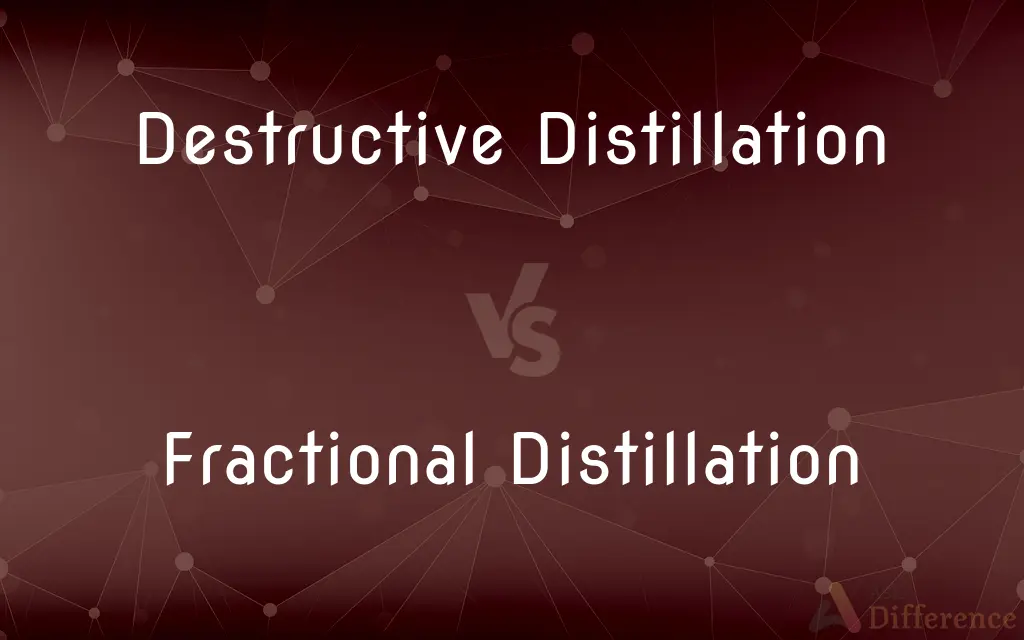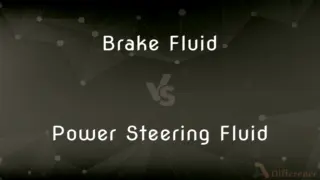Destructive Distillation vs. Fractional Distillation — What's the Difference?
By Tayyaba Rehman — Published on January 8, 2024
Destructive distillation involves heating a substance without air to break it down into volatile parts, whereas fractional distillation separates a mixture into its component parts by their boiling points.

Difference Between Destructive Distillation and Fractional Distillation
Table of Contents
ADVERTISEMENT
Key Differences
Destructive distillation occurs in the absence of air and breaks down the material into several smaller volatile compounds. This process often results in a solid residue and an array of gaseous, liquid, or solid distillates. Fractional distillation, on the other hand, involves the separation of a mixture into its individual components by heating to specific boiling points where each component vaporizes and is collected separately.
In destructive distillation, complex organic substances such as coal, wood, or oil shale are transformed into simpler substances like gases, liquids, and a carbonaceous residue. With fractional distillation, each component of a homogeneous mixture is isolated without chemically altering any of the substances, often used to refine crude oil into its components like gasoline, kerosene, and diesel.
The equipment used for destructive distillation must withstand high temperatures and prevent the entry of air to avoid combustion. For fractional distillation, a fractionating column is essential to achieve the required separation of components, making use of the different boiling points to separate the mixture into fractions that condense at various levels within the column.
The purpose of destructive distillation is to decompose a substance to obtain useful by-products, while maintaining an oxygen-free environment to prevent burning. Fractional distillation aims to purify a substance or separate a mixture based on the volatility of its components, often carried out under atmospheric or reduced pressure.
Destructive distillation is characterized by chemical changes in the starting material, such as the breakdown of long hydrocarbon chains into simpler substances. Fractional distillation is a physical process, where the composition of the starting material remains unchanged, but its components are isolated based on boiling point differences.
ADVERTISEMENT
Comparison Chart
Process Type
Chemical decomposition
Physical separation
Environment
Absence of air (anaerobic)
Presence of air (may be atmospheric or under vacuum)
Product Formation
Various compounds plus a solid residue
Separate components with no residue
Application Example
Coal into coke, gas, and tar
Crude oil into petroleum products
Equipment Used
Retorts or kilns
Fractionating columns
Compare with Definitions
Destructive Distillation
Destructive distillation occurs in a closed system to prevent combustion.
A retort was used for the destructive distillation of the organic sample.
Fractional Distillation
It uses a fractionating column to achieve separation of liquids with close boiling points.
Fractional distillation is used to refine various fractions of crude oil.
Destructive Distillation
Destructive distillation is used to process organic materials into chemicals and fuels.
The destructive distillation of oil shale releases shale oil and gas.
Fractional Distillation
The technique is vital in the petrochemical industry for separating crude oil.
Fractional distillation towers in refineries stand tall to facilitate the separation process.
Destructive Distillation
The process typically yields a variety of gases, liquids, and a solid residue.
Destructive distillation of biomass results in syngas and biochar.
Fractional Distillation
Fractional distillation is a physical process, not inducing chemical changes in the substances.
The laboratory used fractional distillation to purify the chemical sample.
Destructive Distillation
Destructive distillation is the breakdown of substances by heat without air to produce volatile products.
Charcoal is produced by the destructive distillation of wood.
Fractional Distillation
Fractional distillation separates mixtures into individual components based on boiling points.
Fractional distillation is key in producing high-purity ethanol.
Destructive Distillation
It involves chemically altering a substance to extract different chemical products.
During destructive distillation, coal tar is obtained as one of the by-products from coal.
Fractional Distillation
It can separate complex mixtures into pure single components efficiently.
Fractional distillation separated the hydrocarbon mixture into its constituents.
Common Curiosities
What are some products of destructive distillation of coal?
Coke, coal gas, and coal tar are typical products.
Can destructive distillation occur in the presence of air?
No, it must occur in an environment devoid of air to prevent combustion.
What industries use fractional distillation?
The petrochemical and spirits (alcohol) industries commonly use this method.
What is fractional distillation?
Fractional distillation is a technique to separate liquid mixtures into individual components based on differences in boiling points.
Are the products of destructive distillation pure substances?
They often require further purification processes.
Does fractional distillation work for all mixtures?
It's best for mixtures with components having different boiling points.
What is destructive distillation?
It's a process where organic materials are heated in the absence of air to produce volatile compounds and a residue.
Is fractional distillation used for mixtures of solids?
No, it's mainly used for liquid mixtures.
What kind of energy is required for destructive distillation?
High thermal energy is required to decompose the materials.
Why is a fractionating column used in fractional distillation?
It increases the efficiency of the separation process by providing different temperature zones.
Does destructive distillation result in the same components as the original material?
No, it chemically changes the original materials into different substances.
What controls the separation in fractional distillation?
The temperature gradient in the fractionating column controls the separation.
Can destructive distillation lead to pollution?
Yes, if not properly managed, it can produce environmentally harmful by-products.
Is destructive distillation still widely used today?
Yes, particularly in the production of charcoal, activated carbon, and certain chemicals.
Can fractional distillation separate azeotropic mixtures?
It can be challenging; such mixtures may behave as single substances during distillation.
Share Your Discovery

Previous Comparison
Brake Fluid vs. Power Steering Fluid
Next Comparison
Cow Digestive System vs. Human Digestive SystemAuthor Spotlight
Written by
Tayyaba RehmanTayyaba Rehman is a distinguished writer, currently serving as a primary contributor to askdifference.com. As a researcher in semantics and etymology, Tayyaba's passion for the complexity of languages and their distinctions has found a perfect home on the platform. Tayyaba delves into the intricacies of language, distinguishing between commonly confused words and phrases, thereby providing clarity for readers worldwide.











































